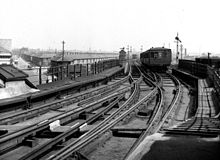Liverpool Overhead Railway
| Liverpool Overhead Railway | |
|---|---|

|
|
| Overview | |
| Other name(s) | Docker's Umbrella |
| Operation | |
| Opened | 6 March 1893 |
| Closed | 30 December 1956 |
| Operator(s) | Liverpool Overhead Railway Company |
| Events | |
| Demolished | September 1957 - January 1958 |
| Technical | |
| Line length | 7 mi (11 km) |
| Number of tracks | 2 |
| Track gauge | 1,435 mm (4 ft 8 1⁄2 in) standard gauge |
| Liverpool Overhead Railway | |||||||||||||||||||||||||||||||||||||||||||||||||||||||||||||||||||||||||||||||||||||||||||||||||||||||||||||||||||||||||||||||||||||||||||||||||||||||||||||||||||||||||||||||||||||
|---|---|---|---|---|---|---|---|---|---|---|---|---|---|---|---|---|---|---|---|---|---|---|---|---|---|---|---|---|---|---|---|---|---|---|---|---|---|---|---|---|---|---|---|---|---|---|---|---|---|---|---|---|---|---|---|---|---|---|---|---|---|---|---|---|---|---|---|---|---|---|---|---|---|---|---|---|---|---|---|---|---|---|---|---|---|---|---|---|---|---|---|---|---|---|---|---|---|---|---|---|---|---|---|---|---|---|---|---|---|---|---|---|---|---|---|---|---|---|---|---|---|---|---|---|---|---|---|---|---|---|---|---|---|---|---|---|---|---|---|---|---|---|---|---|---|---|---|---|---|---|---|---|---|---|---|---|---|---|---|---|---|---|---|---|---|---|---|---|---|---|---|---|---|---|---|---|---|---|---|---|---|
|
|||||||||||||||||||||||||||||||||||||||||||||||||||||||||||||||||||||||||||||||||||||||||||||||||||||||||||||||||||||||||||||||||||||||||||||||||||||||||||||||||||||||||||||||||||||
The Liverpool Overhead Railway (known locally as the Dockers' Umbrella) was an overhead railway in Liverpool which operated along the Liverpool Docks and opened in 1893 with lightweight electric multiple units. The railway had a number world firsts; it was the first electric elevated railway, the first to use automatic signalling & electric colour light signals, electric multiple units, and was home to one of the first passenger escalator at a railway station. It was also the second oldest electric metro in the world being preceded by the 1890 City and South London Railway. In the early 1900s electric trains ran on the electrified Lancashire and Yorkshire Railway to Southport and Aintree. Special trains to Aintree for the horse race meetings ran twice a year after regular services were withdrawn. Being a local railway it was not nationalised in 1948.
Originally spanning 5 miles from Alexandra Dock to Herculaneum Dock, the railway was extended at both ends over the years of operation, as far south as Dingle and north to Seaforth & Litherland. A number of stations opened and closed during the railway's operation owing to relative popularity and damage, including air bombing during World War II. At its peak almost 20 million people used the railway every year.
In 1955, a report into the structure of the many viaducts showed major repairs were needed that the company could not afford. The railway closed at the end of 1956 and despite public protests the structures were dismantled in the following year.
As a result of the massive amount of traffic, congestion, and overcrowding of the dock roads, resulted in many proposals for transport solutions. Rails had appeared in the Liverpool Docks in 1852, linking the warehouses and docks, but for many years horses were used and locomotives were banned because of the risk of fire. From 1859, adapted horse omnibuses ran for passengers on these rails; they had wheel flanges that could be retracted to allow the vehicle to leave the rails and overtake a goods train. By the 1880s, there was an omnibus service every five minutes.
...
Wikipedia
